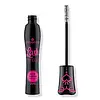Pacifica Vegan Collagen Fluffy Lash Thickening & Lengthening Mascara Versus Essence Lash Princess Mascara
What's inside
What's inside
 Key Ingredients
Key Ingredients

 Benefits
Benefits

 Concerns
Concerns

 Ingredients Side-by-side
Ingredients Side-by-side

Water
Skin ConditioningCopernicia Cerifera Wax
Stearic Acid
CleansingHydrogenated Jojoba Oil
AbrasiveGlyceryl Stearate
EmollientAcacia Senegal Gum
MaskingGlycerin
HumectantOryza Sativa Bran Wax
Skin ConditioningOleic/Linoleic/Linolenic Polyglycerides
EmollientShorea Robusta Resin
TonicOctyldodecanol
EmollientSr-Hydrozoan Polypeptide-1
HumectantCellulose
AbsorbentPectin
Emulsion StabilisingHydrolyzed Vegetable Protein
Skin ConditioningXanthan Gum
EmulsifyingAminomethyl Propanol
BufferingSodium Benzoate
MaskingPhenoxyethanol
PreservativeEthylhexylglycerin
Skin ConditioningCI 77499
Cosmetic ColorantWater, Copernicia Cerifera Wax, Stearic Acid, Hydrogenated Jojoba Oil, Glyceryl Stearate, Acacia Senegal Gum, Glycerin, Oryza Sativa Bran Wax, Oleic/Linoleic/Linolenic Polyglycerides, Shorea Robusta Resin, Octyldodecanol, Sr-Hydrozoan Polypeptide-1, Cellulose, Pectin, Hydrolyzed Vegetable Protein, Xanthan Gum, Aminomethyl Propanol, Sodium Benzoate, Phenoxyethanol, Ethylhexylglycerin, CI 77499
Water
Skin ConditioningRhus Verniciflua Peel Cera
EmollientGlyceryl Stearate Se
EmulsifyingButylene Glycol
HumectantAcacia Senegal Gum
MaskingOryza Sativa Bran Wax
Skin ConditioningPalmitic Acid
EmollientStearic Acid
CleansingAminomethyl Propanol
BufferingVp/Eicosene Copolymer
Helianthus Annuus Seed Oil
EmollientPrunus Amygdalus Dulcis Oil
Skin ConditioningSimmondsia Chinensis Seed Oil
EmollientTocopherol
AntioxidantCopernicia Cerifera Wax
Shorea Robusta Resin
TonicHydroxyethylcellulose
Emulsion StabilisingTocopheryl Acetate
AntioxidantTrimethyl Pentanyl Diisobutyrate
Ethylhexylglycerin
Skin ConditioningSodium Nitrate
SoothingDisodium Phosphate
BufferingSodium Phosphate
BufferingPolysorbate 60
EmulsifyingPhenoxyethanol
PreservativePotassium Sorbate
PreservativeSodium Dehydroacetate
PreservativeCI 77499
Cosmetic ColorantWater, Rhus Verniciflua Peel Cera, Glyceryl Stearate Se, Butylene Glycol, Acacia Senegal Gum, Oryza Sativa Bran Wax, Palmitic Acid, Stearic Acid, Aminomethyl Propanol, Vp/Eicosene Copolymer, Helianthus Annuus Seed Oil, Prunus Amygdalus Dulcis Oil, Simmondsia Chinensis Seed Oil, Tocopherol, Copernicia Cerifera Wax, Shorea Robusta Resin, Hydroxyethylcellulose, Tocopheryl Acetate, Trimethyl Pentanyl Diisobutyrate, Ethylhexylglycerin, Sodium Nitrate, Disodium Phosphate, Sodium Phosphate, Polysorbate 60, Phenoxyethanol, Potassium Sorbate, Sodium Dehydroacetate, CI 77499
 Reviews
Reviews

Ingredients Explained
These ingredients are found in both products.
Ingredients higher up in an ingredient list are typically present in a larger amount.
Acacia Senegal Gum has skin soothing, thickening, and formulation stabilizing properties. It comes from the Acacia tree that is native to sub-Saharan Africa.
Aminomethyl Propanol is used to adjust the pH of products. It is also used as a base to create other organic compounds. Having a balanced pH is important for protecting your skin.
Aminomethyl propanol is safe to use in cosmetics up to 1%. It is soluble in water.
Ci 77499 is also hydrated iron III oxide. It is created from mixing red and black iron oxides. This helps give shades of darkness to a product.
Iron III oxides are classified as inorganic chemicals for coloring.
Copernicia Cerifera Wax comes from a palm tree native to Brazil; another name for this ingredient is Carnauba Wax.
This ingredient is used to thicken texture and also leaves behind a film when applied.
Fun fact: This wax has the highest melting point of all natural waxes and low solubility.
Learn more about Copernicia Cerifera WaxEthylhexylglycerin (we can't pronounce this either) is commonly used as a preservative and skin softener. It is derived from glyceryl.
You might see Ethylhexylglycerin often paired with other preservatives such as phenoxyethanol. Ethylhexylglycerin has been found to increase the effectiveness of these other preservatives.
Oryza Sativa Bran Wax is wax from the outer layer of a rice kernel. It has moisturizing properties due to its polysaccharides and omega-3 fatty acids content.
This ingredient is a byproduct of milling rice, or the operation to produce a whole grain rice product.
Phenoxyethanol is a preservative that has germicide, antimicrobial, and aromatic properties. Studies show that phenoxyethanol can prevent microbial growth. By itself, it has a scent that is similar to that of a rose.
It's often used in formulations along with Caprylyl Glycol to preserve the shelf life of products.
We don't have a description for Shorea Robusta Resin yet.
Stearic Acid is a fatty acid. It is an emollient, emulsifier, and texture enhancer.
As an emollient, stearic acid helps soften skin. It aids the skin's protective barrier by preventing water loss. It also provides a gentle cleansing effect without stripping away natural oils.
Stearic acid may also be used to enhance the texture of products. It can add volume and stabilize ingredients such as water and oil. This can help water and oil ingredients from separating.
Sources of stearic acid include animal or vegetable fats/oils such as coconut or shea. It can be naturally found in butter, cocoa butter, shea butter, vegetable fats, and animal tallow.
This ingredient may not be Malassezia folliculitis, or fungal-acne safe.
Learn more about Stearic AcidWater. It's the most common cosmetic ingredient of all. You'll usually see it at the top of ingredient lists, meaning that it makes up the largest part of the product.
So why is it so popular? Water most often acts as a solvent - this means that it helps dissolve other ingredients into the formulation.
You'll also recognize water as that liquid we all need to stay alive. If you see this, drink a glass of water. Stay hydrated!
Learn more about Water